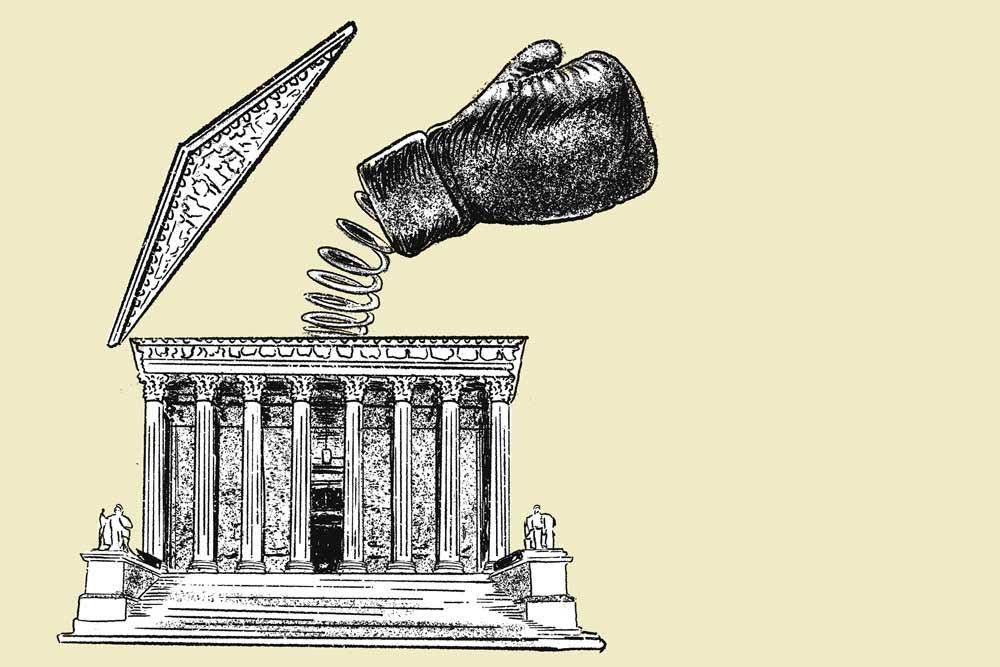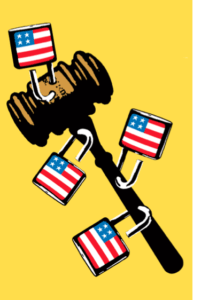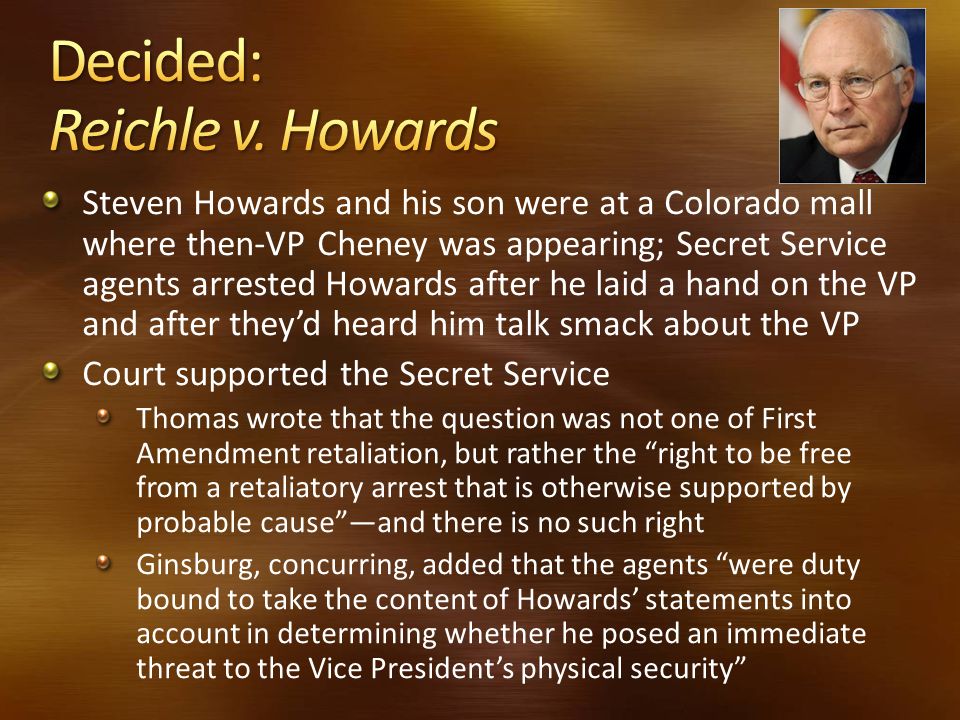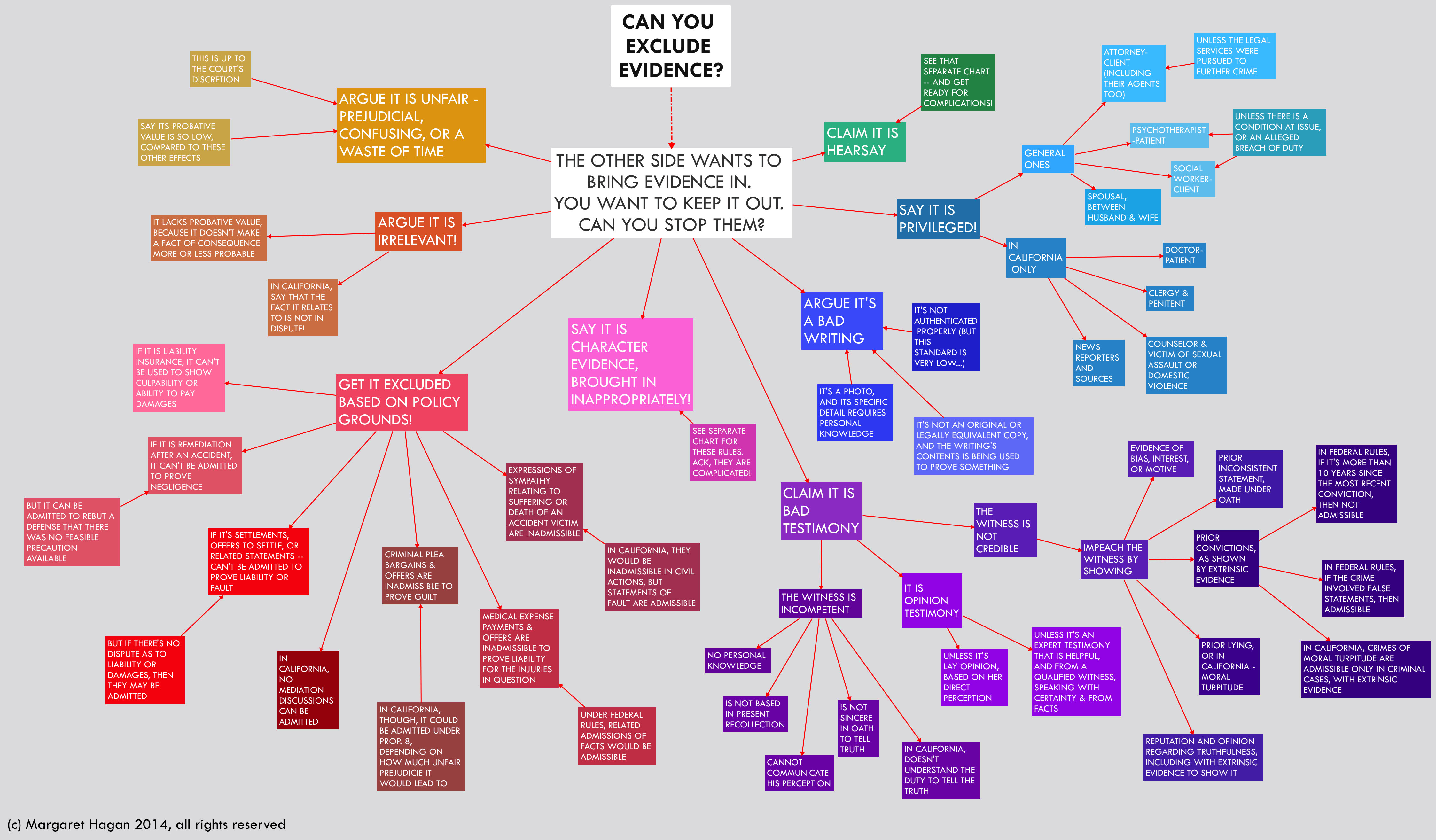Reichle v. Howards (2012) –
Retaliatory Prosecution Claims
Against Government Officials –1st Amendment
By John R. Vile
In Reichle v. Howards, 566 U.S. 658 (2012), the U.S. Supreme Court held that two Secret Service agents, Gus Reichle and Dan Doyle, were entitled to immunity for actions that they had taken in arresting Steven Howards, whom they had probable cause to detain under the Fourth Amendment even though there were allegations that they had made the arrest in retaliation for statements that might be protected by the First Amendment.
![The Supreme Court ruled that qualified immunity applied to Secret Service agents who had arrested a man after he challenged Vice President Dick Cheney in a Colorado mall about his Iraq policies, touching his shoulder in the process. The man had sued, claiming that he was arrested in retaliation for exercising his First Amendment rights. Justice Thomas wrote “[t]his Court has never recognized a First Amendment right to be free from a retaliatory arrest that is supported by probable cause..." (Photo of Secret Service agents in New Orleans by Chuck Patch in Wikimedia Commons, CC BY-SA 2.0)](https://goodshepherdmedia.net/wp-content/uploads/2022/12/Secret_Service_agents_stand_guard_0.jpg)
A federal district court had entered summary judgment for the agents, but the Tenth U.S. Circuit Court of Appeals, while rejecting the Fourth Amendment claims, had allowed the case to proceed on the First Amendment claims.
Justice Clarence Thomas wrote the majority opinion for six justices, while Justice Ruth Bader Ginsburg filed a concurring opinion that Justice Stephen Breyer joined. Justice Elena Kagan took no part in the case.
Howards alleged he had been arrested in retaliation for exercising First Amendment rights
The case arose at a mall in Beaver Creek, Colorado, where agents heard Howards saying he was going to ask Vice President Dick Cheney “How many kids he’s killed today.” He subsequently told Cheney that his “policies in Iraq are disgusting,” and touched his shoulder in the process.
After Howard falsely denied touching the vice president, he was charged with harassment, although this charge was later dismissed. He alleged that he had been arrested and searched without probable cause in violation of the Fourth Amendment and that he had been arrested in retaliation for exercising his First Amendment rights.
Qualified immunity protects officials unless constitutional rights clearly established and violated
Thomas identified two central issues: “whether a First Amendment retaliatory arrest claim may lie despite the presence of probable cause to support the arrest, and whether clearly established law at the time of Howards’ arrest so held,” but decided only to address the second.
In so doing, Thomas argued that “[q]ualified immunity shields governmental officials from civil damages liability unless the official violated a statutory or constitutional right that was clearly established at the time of the challenged conduct.” This required that a reasonable official would understand that his or her behavior violates a right. However, Howards did not establish that threshold here because “[t]his Court has never recognized a First Amendment right to be free from a retaliatory arrest that is supported by probable cause; nor was such a right otherwise clearly established at the time of Howard’s arrest.”
Earlier Court case said individuals could not sue for retaliatory prosecution when there was probable cause
Although there were some opinions from circuit courts establishing the unlawfulness of arrests in retaliation for exercising First Amendment rights, in Hartman v. Moore (2006), the U.S. Supreme Court had held that an individual could not sue for retaliatory prosecution in violation of the First Amendment when the charges were supported by probable cause. And, at the time of Howards’ arrest, “Hartman’s impact on the Tenth Circuit’s precedent governing retaliatory arrests was far from clear.”
Indeed, at the time, retaliatory arrests and retaliatory prosecutions were treated similarly, and a “reasonable official” might have done the same. The decision in Wayte v. United States (1985) gives further support to this view.
Thomas said agents should not be liable for uncertainty in retaliatory arrest law
Thomas specified that he was not saying that Hartman’s rule, or all of its rationale, would apply to retaliatory arrests but that the ruling “injected uncertainty into the law”, for which the agents should not be held liable.
In her concurring opinion Ginsburg stressed that the agents in question were not “ordinary law enforcement officers,” but that they had a big responsibility in guarding the vice president, which often required swift decision-making. She did not think that one could infer “retaliatory animus” on the basis of their actions in arresting Howards.
John Vile is a professor of political science and dean of the Honors College at Middle Tennessee State University. He is co-editor of the Encyclopedia of the First Amendment. This article was originally published in 2009.
cited https://www.mtsu.edu/first-amendment/article/1473/reichle-v-howards
Facts of the case
On June 16, 2006, Steven Howards saw Vice President Dick Cheney while strolling through Beaver Creek Mall. Howards decided to approach the Vice President to protest the President’s polices regarding the Iraq War.
On that day, Gus Reichle and Dan Doyle were part of the Secret Service detail protecting the Vice President. Doyle heard Howards state into his cell phone “I’m going to ask him how many kids he’s killed today.” Howards approached the Vice President and told the Vice President that he disapproved of his policies in Iraq. When the Vice President turned to leave, Howards made unsolicited physical contact with the Vice President by touching the Vice President’s right shoulder with his open hand.
Agent Reichle approached Howards, identified himself as a Secret Service agent, and asked to speak with Howards. After briefly questioning Howards, Reichle arrested him. Howards was initially charged with harassment under state law, but those charges were dismissed. No federal charges were filed.
Howards sued agents Reichle and Doyle under 42 U.S.C. 1983, alleging that the agents had violated his Fourth Amendment right with an unlawful search and seizure and his First Amendment rights by retaliating against him for engaging in constitutionally protected speech. The agents moved for summary judgment on immunity grounds. The district court denied their motion, ruling that fact issues regarding the agents’ immunity defense precluded summary judgment. The agents took an interlocutory appeal to the U.S. Court of Appeals for the Tenth Circuit. They argued that they were entitled to qualified immunity because they had probable cause to arrest Howards and also asserted that they were entitled to heightened immunity by virtue of their status as Secret Service agents protecting the Vice President. The appellate court affirmed in part and reversed in part. The panel unanimously rejected Howards’ Fourth Amendment claim on the grounds that the agents objectively had probable cause to arrest Howards. However, the panel held that probable cause was not a bar to Howards’ First Amendment retaliation claim and that Howards could proceed with his First Amendment retaliation claim notwithstanding the fact that the agents had probable cause for his arrest.
Question
1. Does probable cause to make an arrest bar a First Amendment retaliatory arrest claim?
2. Do Secret Service agents have qualified immunity in the matter of an arrest for which there was probable cause consistent with the Fourth Amendment?
Conclusion
Sort:
-
UNANIMOUS DECISION FOR VIRGIL D. “GUS” REICHLE, JR., ET AL.

John G. Roberts, Jr. 
Antonin Scalia 
Anthony M. Kennedy 
Clarence Thomas 
Ruth Bader Ginsburg 
Stephen G. Breyer 
Samuel A. Alito, Jr. 
Sonia Sotomayor 
Elena Kagan
No answer and Yes. Justice Clarence Thomas delivered the opinion of the court, reversing the 10th Circuit and remanding. The Supreme Court held that the agents have qualified immunity from Howards’ First Amendment claim because there is no clearly established right to protection from retaliatory arrest when there is probable cause for that arrest. For a right to be clearly established, every reasonable officer must understand that he or she is violating that right. The Court has never acknowledged the proposed right in this case, and 10th Circuit precedent is unclear. The Court did not decide whether there is, in fact, a right to protection from retaliatory arrests where there is otherwise probable cause for the arrest.
Justice Ruth Bader Ginsburg concurred, writing that she would not grant qualified immunity if the agents had been ordinary law enforcement officers. She would apply a different standard for officers charged with protecting public officials because they must make quick and decisive decisions to protect the safety of those officials. The agents’ actions in this case were rational and should not expose them to civil damages. Justice Stephen H. Breyer joined in the concurrence. Justice Elena Kagan did not participate in the decision.
cited https://www.oyez.org/cases/2011/11-262
SUPREME COURT OF THE UNITED STATES
Syllabus
REICHLE et al. v. HOWARDS
certiorari to the united states court of appeals for the tenth circuit
No. 11–262. Argued March 21, 2012—Decided June 4, 2012
Petitioners Reichle and Doyle were members of a Secret Service detail protecting Vice President Richard Cheney while he greeted members of the public at a shopping mall. Agent Doyle overheard respondent Howards, who was speaking into his cell phone, state that he “was going to ask [the Vice President] how many kids he’s killed today.” Doyle and other agents observed Howards enter the line to meet the Vice President, tell the Vice President that his “policies in Iraq are disgusting,” and touch the Vice President’s shoulder as the Vice President was leaving. After being briefed by Doyle, Agent Reichle interviewed and then arrested Howards, who was charged with harassment. After that charge was dismissed, Howards brought an action against petitioners and others under 42 U. S. C. §1983 and Bivens v. Six Unknown Fed. Narcotics Agents, 403 U.S. 388. Howards claimed that he was arrested and searched without probable cause, in violation of the Fourth Amendment, and that the arrest violated the First Amendment because it was made in retaliation for Howards’ criticism of the Vice President. Petitioners moved for summary judgment on the ground that they were entitled to qualified immunity, but the Federal District Court denied the motion. On appeal, the Tenth Circuit reversed the immunity ruling with respect to the Fourth Amendment claim because petitioners had probable cause to arrest Howards, but the court affirmed with regard to the First Amendment claim. In doing so, the court rejected petitioners’ argument that, under Hartman v. Moore, 547 U.S. 250, probable cause to arrest defeats a First Amendment retaliatory arrest claim. It concluded instead that Hartman applied only to retaliatory prosecution claims and thus did not upset prior Tenth Circuit precedent holding that a retaliatory arrest violates the First Amendment even if supported by probable cause.
Held: Petitioners are entitled to qualified immunity because, at the time of Howards’ arrest, it was not clearly established that an arrest supported by probable cause could give rise to a First Amendment violation. Pp. 5−12.
(a) Courts may grant qualified immunity on the ground that a purported right was not “clearly established” by prior case law. Pearson v. Callahan, 555 U.S. 223, 236. To be clearly established, a right must be sufficiently clear “that every ‘reasonable official would [have understood] that what he is doing violates that right.’ ” Ashcroft v. al-Kidd, 563 U. S. ___, ___. Pp. 5−6.
(b) The “clearly established” standard is not satisfied here. This Court has never recognized a First Amendment right to be free from a retaliatory arrest that is supported by probable cause; nor was such a right otherwise clearly established at the time of Howards’ arrest. P. 6.
(c) At that time, Hartman’s impact on the Tenth Circuit’s precedent was far from clear. Although Hartman’s facts involved only a retaliatory prosecution, reasonable law enforcement officers could have questioned whether its rule also applied to arrests. First, Hartman was decided against a legal backdrop that treated retaliatory arrest claims and retaliatory prosecution claims similarly. Itresolved a Circuit split concerning the impact of probable cause on retaliatory prosecution claims, but some of the conflicting cases involved both retaliatory prosecution and retaliatory arrest claims and made no distinction between the two when considering the relevance of probable cause. Second, a reasonable official could have interpreted Hartman’s rationale to apply to retaliatory arrests. Like in retaliatory prosecution cases, evidence of the presence or absence of probable cause for the arrest will be available in virtually all retaliatory arrest cases, and the causal link between the defendant’s alleged retaliatory animus and the plaintiff’s injury may be tenuous. Finally, decisions from other Circuits in the wake of Hartman support the conclusion that, for qualified immunity purposes, it was at least arguable at the time of Howards’ arrest that Hartman extended to retaliatory arrests. Pp. 7−12.
634 F.3d 1131, reversed and remanded.
Thomas, J., delivered the opinion of the Court, in which Roberts, C. J., and Scalia, Kennedy, Alito, and Sotomayor, JJ., joined. Ginsburg, J., filed an opinion concurring in the judgment, in which Breyer, J., joined. Kagan, J., took no part in the consideration or decision of the case. cited https://supreme.justia.com/cases/federal/us/566/658/
Learn more about these sujects
- Malicious Prosecution
- Prosecutional Misconduct
- Vindictive Prosecution
- Retaliatory Prosecution
- Abuse of Process
Selected Issues in Malicious Prosecution Cases
Malicious Prosecution / Prosecutorial Misconduct
Vindictive Prosecution – Georgetown University
VINDICTIVE AND SELECTIVE PROSECUTION
What is Abuse of Process?
Defeating Extortion and Abuse of Process in All Their Ugly Disguises
What’s the Difference between Abuse of Process and Malicious Prosecution?
Malicious Prosecution Actions Arising Out Of Family Law Proceedings: Proceed Carefully
Frivolous, Meritless or Malicious Prosecution
SCOTUS Makes It Easier To Sue Police And Prosecutors For Malicious Prosecution
Prosecutional Misconduct – SCOTUS Rulings re: Prosecutors
National District Attorneys Association – National Prosecution Standards – NDDA
What Happens If Charges Are Dropped Before Trial?
Functions and Duties of the Prosecutor – Prosecution Conduct
Possible courses of action Prosecutorial Misconduct
Misconduct by Judges & Prosecutor – Rules of Professional Conduct
PC 1385 – Dismissal of the Action for Want of Prosecution or Otherwise
Thomp$on v. Clark – Maliciou$ Pro$ecution
Reichle v. Howards (2012) – Retaliatory Prosecution Claims Against Government Officials –1st Amendment
People v. Superior Court (Greer) 5th & 8th Amendment – Bias / Malicious Persecutor
Hartman v. Moore (2006) –Retaliatory Prosecution Claims Against Government Officials – 1st Amendment
What is a Fiduciary Duty; Breach of Fiduciary Duty
Epic SCOTUS Decisions
To Learn More…. Read MORE Below and click the links
Abuse & Neglect – The Reporters (Police, D.A & Medical & the Bad Actors)
If You Would Like to Learn More About: The California Mandated Reporting Law Click Here
To Read the Penal Code § 11164-11166 – Child Abuse or Neglect – California Penal Code 11164-11166
Child Abuse and Neglect Reporting Act Article 2.5. (CANRA) Click Here
Mandated Reporter formclick linkMandated Reporter FORM SS 8572.pdf – The Child Abuse
ALL POLICE CHIEFS, SHERIFFS AND COUNTY WELFARE DEPARTMENTS
INFORMATION BULLETIN Click H ere Officers and DA’s for (Procedure to Follow)
It Only Takes a Minute to Make a Difference in the Life of a Child
Learn More About True Threats Here below….
We also have the The Brandenburg v. Ohio (1969) – 1st Amendment
CURRENT TEST = We also have the The ‘Brandenburg test’ for incitement to violence – 1st Amendment
We also have the The Incitement to Imminent Lawless Action Test– 1st Amendment
We also have the True Threats – Virginia v. Black is most comprehensive Supreme Court definition – 1st Amendment
We also have the Watts v. United States – True Threat Test – 1st Amendment
We also have the Clear and Present Danger Test – 1st Amendment
We also have the Gravity of the Evil Test – 1st Amendment
We also have the Elonis v. United States (2015) – Threats – 1st Amendment
Learn More About What is Obscene…. be careful about education it may enlighten you
We also have the Miller v. California – 3 Prong Obscenity Test (Miller Test) – 1st Amendment
We also have the Obscenity and Pornography – 1st Amendment
Learn More About Police, The Government Officials and You….
$$ Retaliatory Arrests and Prosecution $$
We also have the Brayshaw v. City of Tallahassee – 1st Amendment – Posting Police Address
We also have the Publius v. Boyer-Vine –1st Amendment – Posting Police Address
We also have the Lozman v. City of Riviera Beach, Florida (2018) – 1st Amendment – Retaliatory Police Arrests
We also have the Nieves v. Bartlett (2019) – 1st Amendment – Retaliatory Police Arrests
We also have the Hartman v. Moore (2006) – 1st Amendment – Retaliatory Police Arrests
Retaliatory Prosecution Claims Against Government Officials – 1st Amendment
We also have the Reichle v. Howards (2012) – 1st Amendment – Retaliatory Police Arrests
Retaliatory Prosecution Claims Against Government Officials – 1st Amendment
Learn More About Police, The Government Officials and You….
We also have the Freedom of the Press – Flyers, Newspaper, Leaflets, Peaceful Assembly – 1st Amendment
We also have the Insulting letters to politician’s home are constitutionally protected, unless they are ‘true threats’ – 1st Amendment
We also have the Introducing TEXT & EMAIL Digital Evidencein California Courts – 1st Amendment
We also have the First Amendment Encyclopedia very comprehensive – 1st Amendment
ARE PEOPLE LYING ON YOU? CAN YOU PROVE IT? IF YES…. THEN YOU ARE IN LUCK!
We also have the Penal Code 118 PC – California Penalty of “Perjury” Law
We also have the Federal Perjury – Definition by Law
We also have the Penal Code 132 PC – Offering False Evidence
We also have the Penal Code 134 PC – Preparing False Evidence
We also have the Penal Code 118.1 PC – Police Officers Filing False Reports
We also have the Spencer v. Peters– Police Fabrication of Evidence – 14th Amendment
We also have the Penal Code 148.5 PC – Making a False Police Report in California
We also have the Penal Code 115 PC – Filing a False Document in California
Sanctions and Attorney Fee Recovery for Bad Actors
FAM § 3027.1 – Attorney’s Fees and Sanctions For False Child Abuse Allegations – Family Code 3027.1 – Click Here
FAM § 271 – Awarding Attorney Fees– Family Code 271 Family Court Sanction Click Here
Awarding Discovery Based Sanctions in Family Law Cases – Click Here
FAM § 2030 – Bringing Fairness & Fee Recovery – Click Here
Know Your Rights Click Here (must read!)
Under 42 U.S.C. $ection 1983 – Recoverable Damage$
42 U.S. Code § 1983 – Civil Action for Deprivation of Right$
$ection 1983 Lawsuit – How to Bring a Civil Rights Claim
18 U.S. Code § 242 – Deprivation of Right$ Under Color of Law
18 U.S. Code § 241 – Conspiracy against Right$
$uing for Misconduct – Know More of Your Right$
Police Misconduct in California – How to Bring a Lawsuit
Malicious Prosecution / Prosecutorial Misconduct – Know What it is!
New Supreme Court Ruling – makes it easier to sue police
RELATIONSHIP WITH YOUR CHILDREN & YOUR CONSTITUIONAL RIGHT$ + RULING$
YOU CANNOT GET BACK TIME BUT YOU CAN HIT THOSE PUNKS WHERE THEY WILL FEEL YOU = THEIR BANK
We also have the 9.3 Section 1983 Claim Against Defendant as (Individuals) — 14th Amendment thisCODE PROTECTS all US CITIZENS
We also have the Amdt5.4.5.6.2 – Parental and Children’s Rights 5th Amendment thisCODE PROTECTS all US CITIZENS
We also have the 9.32 – Interference with Parent / Child Relationship – 14th Amendment thisCODE PROTECTS all US CITIZENS
We also have the California Civil Code Section 52.1Interference with exercise or enjoyment of individual rights
We also have the Parent’s Rights & Children’s Bill of RightsSCOTUS RULINGS FOR YOUR PARENT RIGHTS
We also have a SEARCH of our site for all articles relatingfor PARENTS RIGHTS Help!
GRANDPARENT CASE LAW
Troxel v. Granville, 530 U.S. 57 (2000) – Grandparents – 14th Amendment
Third “PRESUMED PARENT” Family Code 7612(C) – Requires Established Relationship Required
S.F. Human Servs. Agency v. Christine C. (In re Caden C.)
9.32 Particular Rights – Fourteenth Amendment – Interference with Parent / Child Relationship
Parent’s Rights & Children’s Bill of Rights
Cal State Bar PDF to read about Three Parent Law – The State Bar of California family law news issue4 2017 vol. 39, no. 4.pdf
Contesting / Appeal an Order / Judgment / Charge
Options to Appealing– Fighting A Judgment Without Filing An Appeal Settlement Or Mediation
Cal. Code Civ. Proc. § 1008 Motion to Reconsider
Penal Code 1385 – Dismissal of the Action for Want of Prosecution or Otherwise
Penal Code 1538.5 – Motion To Suppress Evidence in a California Criminal Case
CACI No. 1501 – Wrongful Use of Civil Proceedings
Penal Code “995 Motions” in California – Motion to Dismiss
WIC § 700.1 – If Court Grants Motion to Suppress as Evidence
 Epic Criminal / Civil Rights SCOTUS Help – Click Here
Epic Criminal / Civil Rights SCOTUS Help – Click Here
 Epic Parents SCOTUS Ruling – Parental Rights Help – Click Here
Epic Parents SCOTUS Ruling – Parental Rights Help – Click Here
 Judge’s & Prosecutor’s Jurisdiction– SCOTUS RULINGS on Judicial & Prosecutorial Conduct
Judge’s & Prosecutor’s Jurisdiction– SCOTUS RULINGS on Judicial & Prosecutorial Conduct
Family Treatment Court Best Practice Standards
Download Here this Recommended Citation
Please take time to learn new UPCOMING
The PROPOSED Parental Rights Amendment
to the US CONSTITUTION Click Here to visit their siteThe proposed Parental Rights Amendment will specifically add parental rights in the text of the U.S. Constitution, protecting these rights for both current and future generations.
The Parental Rights Amendment is currently in the U.S. Senate, and is being introduced in the U.S. House.


